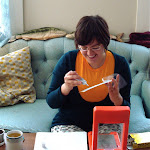
I feel silly for promising write an upholstery tutorial on a Friday night. I am pretty sleepy after enjoying a slow meal with an old friend and I just remembered I am supposed to bake a rum cake to celebrate my Dad's 86th birthday.
I wish I'd planned on writing a tutorial post before I actually completed this chair project because I would have taken more process pictures. The above photo is of one of the dining chairs before I started working on it. Hopefully my instructions will be easy to follow and if something is confusing, feel free to ask for clarification and I'll be sure to answer in the comments. This project is about as simple as upholstery gets and can be done without any sewing.
Here is what you'll be needing:
- chairs with seat panels that can be fully unscrewed and taken off the chair frame
- screwdriver
- 1" tall foam rubber (how much you need depends on your chairs and you can select firmness)
- cotton batting (enough to cover all your seat tops)
- spray adhesive "Foam Lock"
- shears (I love my Gingher 10" shears for upholstery projects)
- staple puller
- mallet
- respirator (optional if you are invincible)
- straight ruler
- measuring tape
- marker
- staple gun
- 3/8" staples
- fabric
- steam iron
Start by flipping your chairs over and removing the screws that hold the seat panels on. I recommend labeling which panel went with which chair frame to insure that the holes line up at the end when putting your finished panel back on. Check your chair for sturdiness and set your chair frame aside with wood glue touch ups and tightly clamped if you found it wobbly.
STRIP!
Now scoop up your disembodied seat panels, your staple puller and your mallet and go to town getting that pre-existing upholstery off in any way you can. You may even want to wear a dust mask if your furniture is old or secondhand. Foam deteriorates over time and other people's dust isn't something you want to inhale.
My preferred stripping technique (get all our pervy eyebrow raises out of your system now) is to hold the staple puller at an angle and tap the end with a mallet so that the puller digs up under each staple and pings it out with a good whack. The staples can be wiggled out without the mallet but it takes longer. If you are lucky, the previous upholsterer may even have done a lazy job and there won't be too many staples. More often than not, you will find that as soon as you remove the upholstery, there is another older layer of fabric beneath. I have stripped cushions with four layers of fabric to get through! You may be tempted to just staple your new fabric over the old stuff and skip the stripping step altogether but that is not the way to treat your butt. Your chairs will be much more comfortable if you strip the seats all the way down to the wood and then add a fresh new layer of cushioning.
Cushiony Comfort!
Now that all the staples are out of the wood and your old fabric is removed, give your cushion a little squeeze. If the foam bounces back and seems full and tempting to sit on, you do not need to add new foam. Even if your foam is still in decent shape, it probably needs to be freshened up. You can puff up the spots on your foam that have become compressed by the weight of your dinner guests with steam from an iron slowly hovering above it's surface. This doesn't always work but when it does, it is a delight and reminds me of those capsules you could soak in water that would become tiny dinosaur sponges. You lucky folks with decent foam can skip the next paragraph about foam cutting and catch up at the top layer of cotton.
Most seat panels will need to be stripped down to the wood and the old foam disposed of. If your chairs are antiques, the padding you encounter may be straw, horsehair or cotton instead of foam. Once you are down to the wood on the seats, get your sheet of one inch foam and lay it flat on a table and then place your seat panels on top. Trace the outlines of your seat panels onto the foam sheet with a marker. Be sure not to assume that all the panels are identical and just trace one over and over again because dining chair sets often have a "captain's chair" that is wider than the rest. Cutting foam is usually done with a foam saw but I have heard that some people can get by with an electric meat carving knife. Since the foam for this project is only 1" tall, a good pair of shears can do the job just fine. Cut along the lines you traced and then your foam will be ready to get stuck to the seat with spray adhesive "Foam Lock". Spray adhesive is a product that does the job but will probably kill your brain cells so I always wear a respirator when spraying. Apply a few light sweeps of the spray adhesive to the top of the seat panel and then a few to the bottom of the foam. Match up the sticky sides following the contours of the chair and your foam should stay in place.
Now take a generous square of cotton batting and lay it on top of the foam. Cotton pulls apart easily so you will not need scissors to trim the excess cotton; just use a guiding hand along the contours of the seat while gently pulling the cotton off . You should be left with a wooden panel topped with foam and a layer of cotton without any lumps of excess cotton around the edges.
Your panels are now ready to be covered but I'm going to leave you in suspense and post part two of this tutorial on Monday evening. I feel bad but I've got to get cooking on that rum cake or my Dad will be one surly senior citizen.
Friday, March 25, 2011
dining chair cushion recovery mission! Part 1
Posted by
Elise of Argyle Whale
at
6:33 PM
![]()
Labels: dining chair, diy, panel, seat, tutorial, upholstery
Subscribe to:
Post Comments (Atom)







No comments:
Post a Comment